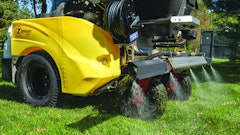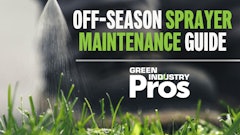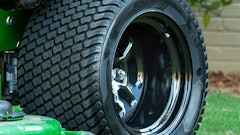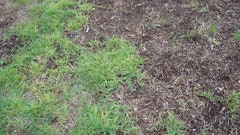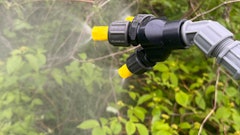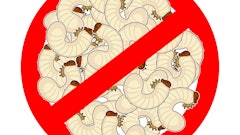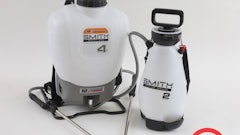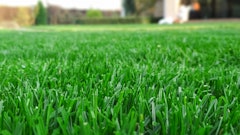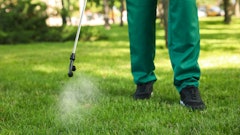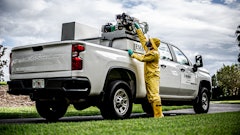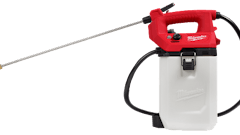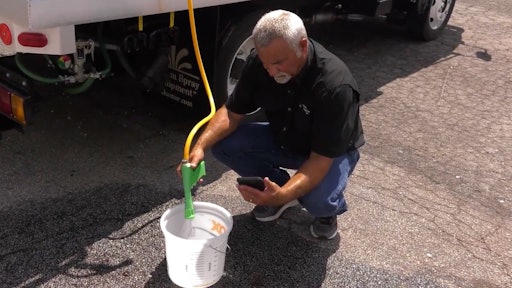
Without question, lawn care operators must perform midseason maintenance on their sprayers’ various components in order to ensure their efficiency and safety remain high.
Check the components
As operators prepare to conduct such maintenance, Christian Jessel, category manager, equipment, SiteOne Landscape Supply, advises them to first focus on their sprayers’ batteries. They must inspect each battery for any signs of damage or wear. And their terminals should be cleaned to guarantee that connections remain highly reliable.
“To maximize battery life, operators should also follow their manufacturers’ guidelines, concerning charging and storage,” Jessel emphasizes.
In addition, operators must thoroughly clean their sprayers every time they utilize them, focusing particularly on removing debris and residue that may clog nozzles or negatively impact their sprayers’ performances. While doing so, Jessel recommends operators to remove batteries from their sprayers’ battery compartments and maintain their connections’ dryness whenever they clean them.
At the same time, if necessary, operators should also lubricate their sprayers’ pumps, while seeking to follow their manufacturers’ instructions. They can inspect their sprayers’ pump seals and O-rings for any damage or and then replace them whenever necessary.
“For seals, a thin coating of petroleum jelly, like Vaseline, is recommended,” Jessel adds.
Meanwhile, operators must check their sprayers’ filters for buildups and clogs as well. To prevent potential blockages and, in turn, maintain proper flow, they should clean or replace their filters, especially if damage can’t be reversed.
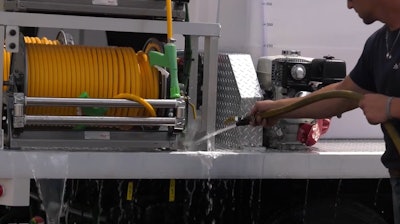 Operators must wash their rigs at least once a week to remove any spray chemical residue.Graham Spray Equipment
Operators must wash their rigs at least once a week to remove any spray chemical residue.Graham Spray Equipment
“And, finally, operators must inspect their sprayers’ backpack straps and harnesses for any signs of damage, discomfort or wear,” Jessel says. “Upon doing so, they can replace any worn-out or broken parts to guarantee safety and ease of use.”
Prevent clogging, observe signs of wear
Robert Perkins, parts manager, Graham Spray Equipment, believes lawn care operators should also check their sprayers’ engine oil during their midseason maintenance. If oil levels are low, they must increase them. If oil is dark or has debris in it, then they should conduct an oil change.
Additionally, they should clean their sprayers’ screens every day to prevent clogging, which typically interferes with flow rates, and they must wash their spray rigs once a week, at minimum, throughout the entire season.
“Residue from spray chemicals causes corrosion,” Perkins explains. “Weekly washes increase spray rigs’ longevity and helps maintain their professional appearances.”
In the meantime, operators should bucket test their pumps, too. To do so, they can release three gallons of liquid from their sprayers’ tanks into a bucket, while recording how long it takes to completely empty them. According to Perkins, every minute of liquid release is similar to spraying three gallons per 1,000 square feet of lawn.
Of equal importance, operators should also observe their belts, while checking the tension on idlers and looking for cracks, dry rot and other signs of wear.
“If a belt needs to be tightened, be sure to leave a half-inch of spring in it,” Perkins adds.
 Lawn care operators should clean or replace their sprayer nozzles as needed, in order to maintain proper spray pattern and flow.SiteOne Landscape Supply
Lawn care operators should clean or replace their sprayer nozzles as needed, in order to maintain proper spray pattern and flow.SiteOne Landscape Supply
“I would suggest going through the sprayer, cleaning filters and checking O-rings, specifically on the suction side of the pump, as those often cause air leaks, which prevent sprayers from building pressure,” Smith says.
Maintain hoses, nozzles, reels and tanks
To enhance their sprayers’ efficiency, Jessel, Perkins and Smith recommend lawn care operators to especially focus on their hoses, nozzles, reels and tanks—offering them the following recommendations.
Hoses and reels. According to Smith, since hoses will wear out over time, operators should periodically check for signs of wear, including cracks, dry rot and leaks.
“An easy way to extend a spray hose’s life is to flip it end for end,” he says. “This will put the hose that is always dragging on the ground farther back on the reel so that it won’t be used as much.”
Perkins—who believes that operators should pay for high-quality hoses and reels, rather than “cut corners that will cause troubles sooner, rather than later”—adds that an entire hose should be unrolled off a reel and then rewound back on it to verify that the reel is working properly.
Jessel agrees with Smith and Perkins, adding that hoses should be cleaned regularly to remove any debris and dirt that may clog nozzles or impede water flow.
“Also, replace damaged hoses promptly to prevent water loss and ensure proper irrigation,” Jessel says.
Smith notes that hose reels don't require such maintenance.
"However, it’s good practice to have a spare push button and solenoid on hand," Smith notes.
Nozzles. Much like hoses, nozzles should be inspected for blockages and clogs, too. Jessel suggests operators use a small brush or toothpick to remove any debris that may obstruct nozzle openings. Additionally, to prevent potential buildup, they can clean their nozzles with a mild detergent.
If problems ever arise in the future, Perkins thinks operators should consider having replacement nozzles on hand as well, while Smith recommends they utilize add-on attachments.
“Attachments, such as high-pressure filters, can reduce nozzle clogging, along with downtime, as nozzles won’t have to be cleaned in the field,” Smith emphasizes.
Tanks. Finally, Perkins advises operators to wash their sprayers’ tanks at least once a week to prevent chemical residue-related corrosion and increase each rig’s lifespan. Furthermore, Smith believes operators should flush out any remaining mixtures in tanks, particularly if their sprayers won’t be utilized for extensive time periods.
“Operators should especially clean and rinse tanks that are used for spraying fertilizers, pesticides and other lawn care chemicals, while also ensuring tank caps are securely sealed,” Jessel says. “And, they should always inspect their tanks for signs of damage, which may compromise their integrity.”





